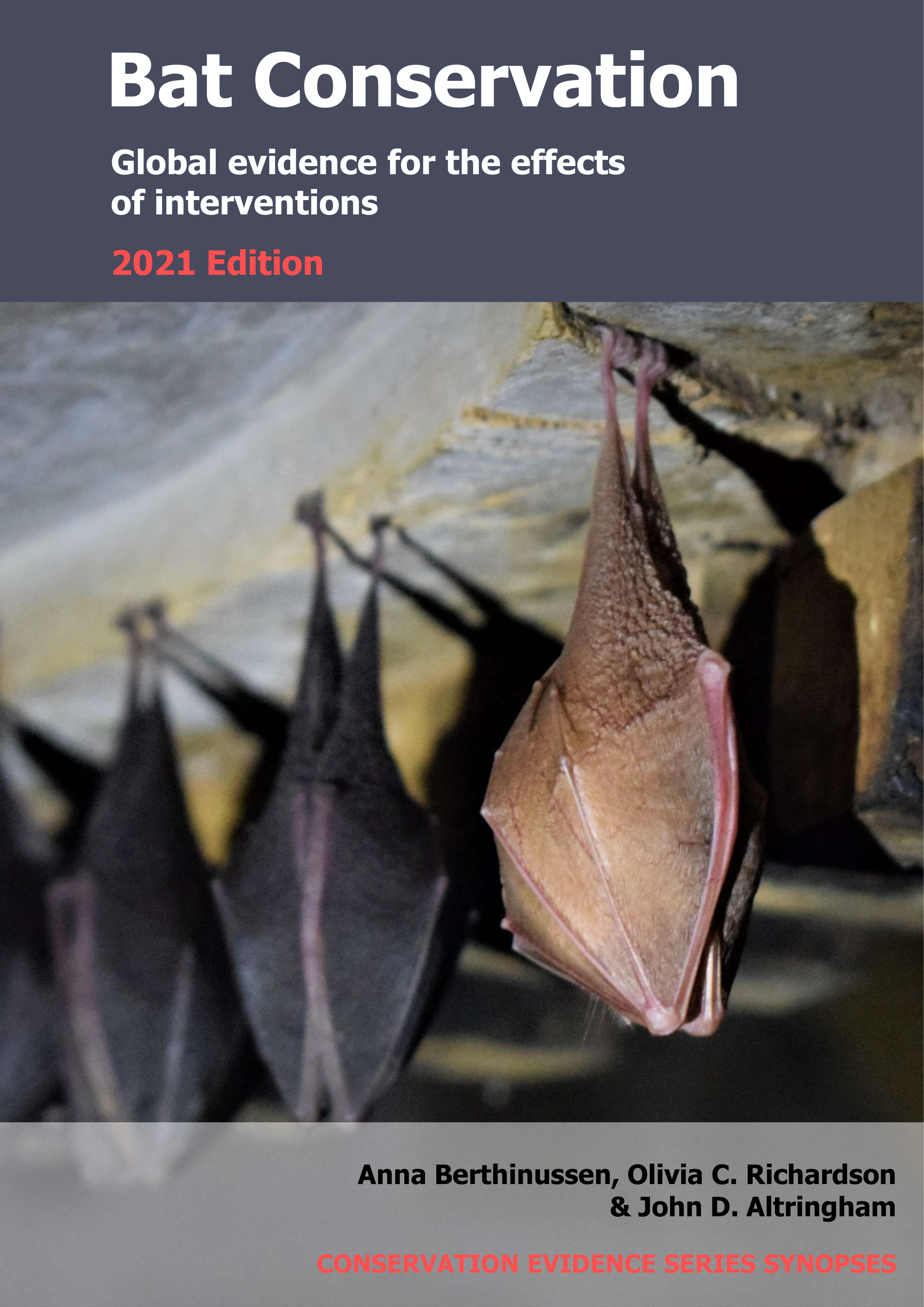Actions to conserve biodiversity
We have summarised evidence from the scientific literature about the effects of actions to conserve wildlife and ecosystems.
Review the evidence from the studies
Not sure what Actions are? Read a brief description.
Search for evidence
e.g. "frogs chytrid"
200 Actions found
Refine
Hide
200 Actions found
Download Actions
| 0 selected |
|
Order results by:
| Action | Effectiveness | Studies | Category | |
|---|---|---|---|---|
|
Relocate bats from reclaimed mines to alternative subterranean roost sites Action Link |
No evidence found (no assessment) | 0 |
|
|
|
Vaccinate bats against the white-nose syndrome pathogen Action Link |
No evidence found (no assessment) | 0 |
|
|
|
Cull bats infected with white-nose syndrome Action Link |
No evidence found (no assessment) | 0 |
|
|
|
Introduce legislation to control the use of hazardous substances Action Link |
No evidence found (no assessment) | 0 |
|
|
|
Change effluent treatments used in agriculture and forestry Action Link |
No evidence found (no assessment) | 0 |
|
|
|
Impose noise limits in proximity to bat roosts and habitats Action Link |
No evidence found (no assessment) | 0 |
|
|
|
Use mammal-safe timber treatments in roof spaces Action Link |
No evidence found (no assessment) | 0 |
|
|
|
Install sound-proofing insulation between bat roosts and areas occupied by humans within developments Action Link |
No evidence found (no assessment) | 0 |
|
|
|
Plant gardens with night-scented flowers Action Link |
No evidence found (no assessment) | 0 |
|
|
|
Increase semi-natural habitat within gardens Action Link |
No evidence found (no assessment) | 0 |
|
|
|
Provide training to conservationists, land managers, and the building and development sector on bat ecology and conservation to reduce bat roost disturbance Action Link |
No evidence found (no assessment) | 0 |
|
|
|
Protect greenfield sites or undeveloped land in urban areas Action Link |
No evidence found (no assessment) | 0 |
|
|
|
Provide or retain set-aside areas in farmland Action Link |
No evidence found (no assessment) | 0 |
|
|
|
Increase the proportion of semi-natural habitat in the farmed landscape Action Link |
No evidence found (no assessment) | 0 |
|
|
|
Plant new hedges Action Link |
No evidence found (no assessment) | 0 |
|
|
|
Manage ditches to benefit bats Action Link |
No evidence found (no assessment) | 0 |
|
|
|
Retain existing in-field trees Action Link |
No evidence found (no assessment) | 0 |
|
|
|
Plant in-field trees Action Link |
No evidence found (no assessment) | 0 |
|
|
|
Retain remnant forest or woodland on agricultural land Action Link |
No evidence found (no assessment) | 0 |
|
|
|
Avoid the use of antiparasitic drugs for livestock Action Link |
No evidence found (no assessment) | 0 |
|
|
|
Manage grazing regimes to increase invertebrate prey Action Link |
No evidence found (no assessment) | 0 |
|
|
|
Educate homeowners about building and planning laws relating to bats to reduce disturbance to bat roosts Action Link |
No evidence found (no assessment) | 0 |
|
|
|
Prevent culling of bats around fruit orchards Action Link |
No evidence found (no assessment) | 0 |
|
|
|
Introduce certification for bat-friendly crop harvesting regimes Action Link |
No evidence found (no assessment) | 0 |
|
|
|
Deter bats from turbines using low-level ultraviolet light Action Link |
No evidence found (no assessment) | 0 |
|
Download Actions
| 0 selected |
|

Bat Conservation - Published 2021
Update 2020
Watch this search
If you are familiar with RSS feeds, please click the button below to retrieve the feed URL:
RSS feed for this searchIf you are unfamiliar with RSS feeds, we would suggest reading this BBC article.
Unfortunately, due to the number of feeds we have available, we cannot provide e-mail updates. However, you could use tools such as Feed My Inbox to do this for you.
What are 'Individual studies' and 'Actions'?
Individual studies
An individual study is a summary of a specific scientific study, usually taken from a scientific journal, but also from other resources such as reports. It tells you the background context, the action(s) taken and their consequences.
If you want more detail please look at the original reference.
Actions
Each action page focuses on a particular action you could take to benefit wildlife or ecosystems.
It contains brief (150-200 word) descriptions of relevant studies (context, action(s) taken and their consequences) and one or more key messages.
Key messages show the extent and main conclusions of the available evidence. Using links within key messages, you can look at the paragraphs describing each study to get more detail. Each paragraph allows you to assess the quality of the evidence and how relevant it is to your situation.
Where we found no evidence, we have been unable to assess whether or not an intervention is effective or has any harmful impacts.





)_2023.JPG)














